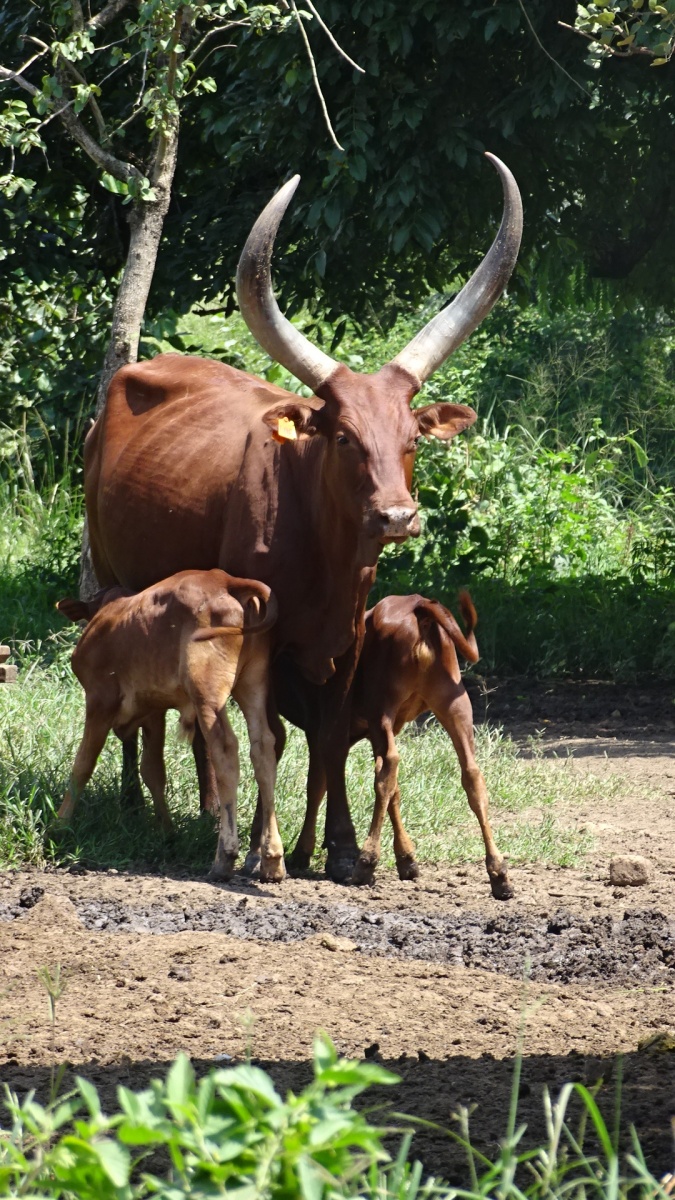
Former ILRI researcher champions Brachiaria farming in Uganda
Former International Livestock Research Institute (ILRI) scientist, Morris Agaba, is a livestock farmer in Masindi District, which lies in the cattle corridor of western Uganda. Agaba farms Brachiaria grass, an important climate-change forage in East Africa, on 25-acres of his farm.
In early February, he had a conversation with Mwihaki Mundia, the Biosciences eastern and central Africa - International Livestock Research Institute (BecA-ILRI) Hub's communications officer about his experience pioneering Brachiaria grass on his farm and in his village, Kinuma village, in Masindi District.
Mundia: What is the size of your farm and what sparked your interest in Brachiaria grass?
Agaba: My farmland covers a total area of about 495 acres. This includes a substantial area with native vegetation cover. I learnt about Brachiaria grass in my time as research scientist in molecular biology at the BecA-ILRI Hub. I often overheard my colleagues speak about the grass. It sounded like an incredible and highly beneficial forage to have. When I decided to start a livestock farm, I thought it is prudent to include Brachiaria as a key source of forage on my farm.
Mundia: What livestock species do you keep and how many are they?
Agaba: I keep 70 head of indigenous cattle, 20 sheep and 100 goats. I also keep poultry – chicken and turkey.

Twinning in indigenous cattle is rare, but this heifer delivered twins.
Brachiaria grass has improved the fertility of cows
Mundia: Are you growing any crops on your farm?
Agaba: I’m farming maize and beans, mainly for subsistence use.
Mundia: How long have you been growing Brachiaria grass?
Agaba: I have had this farm for the past four years and in that time, I’ve grown Brachiaria throughout. I received source seeds and the necessary technical information on Brachiaria production free of charge from the BecA-ILRI Hub. We started off with a trial half kilo of seeds, planted on an acre of land, that had encouraging results. I then obtained more seeds of three varieties: Basilisk, Piata and Xaraes, and planted them on 10 acres. I now have a total of 25 acres of mostly the Xaraes variety planted.
Mundia: With so much acreage under Brachiaria, do you sell the grass?
Agaba: No, not yet, the grass is all consumed by the livestock on the farm but I’m considering it because we are currently planning on expanding the acreage under Brachiaria.
Mundia: What has your experience with the grass been in terms of its feed quality, feed availability, drought tolerance and its effect on livestock productivity, health and well-being?
Agaba: My experience with feed availability has been fantastic, I have not experienced a shortage of the grass yet. Our cattle herd has grown in number and this is the main reason we are expanding acreage under Brachiaria. The productivity of the animals has been great with good body condition scores, high herd fertility and fast calf growth. The herd’s health and well-being has been constantly good, and as for drought tolerance, this was proven at the start of the year 2020 when there was an uncharacteristic four-month-long dry spell with no rain and the Brachiaria grass stayed healthy. As for the quality, judging by the rate of consumption, the cows love it.
Mundia: How is your experience with managing pests and diseases in Brachiaria farming?
Agaba: We have not had a problem with pests, the grass is not attacked by termites, which we have in plenty. This is unlike other forage like Calliandra or even maize, which are heavily attacked by termites. But we have noticed some patches where the grass appears to have a disease characterized by very narrow leaves.
Mundia: What do you wish would be better about the grass?
Agaba: I think it would be more beneficial if the grass produced seeds.
Mundia: What are some of the important lessons you have picked up while farming Brachiaria grass?
Agaba: Establishing Brachiaria is like growing any other crop especially at the initial stages. It needs tending to, weeding and at least a good downpour during transplanting of the tillers. Secondly, we need to develop a more efficient method for transplanting tillers. We allow the animals to graze directly on the grass, which works great as long as the grass is given ample time to grow initially (about six months) before letting cattle graze directly on it. We have also noticed that cattle prefer to graze on the Basilisk variety more than they do on Piata or Xaraes varieties. We have also noticed that sheep also benefit significantly from the grass.
Mundia: What advice would you give to other farmers who are interested in farming the grass?
Agaba: Get on with it! Initially, find someone with experience and get help to establish the first plot. Start small and learn as you grow.
Mundia: Do you support other farmers in your community /district/country to grow Brachiaria grass? If so, what support do you give?
Agaba: We do support livestock keepers in the immediate neighborhood and beyond. We have opened our gates to farmers to visit and learn about the grass. It isn’t a tradition or common practice here for people to grow pastures hence seeing is believing for them. We also provide limited planting material free of charge to those farmers who want to experiment. So far, we have provided materials to more than a dozen farmers within the district. Most of them have successfully established one to three acres of their own plots and from which they can expand. The feedback from them has been very positive.
Xaraes cultivar at the peak of the dry season

Regrowth of Xaraes cultivar four weeks after the rainy season began





